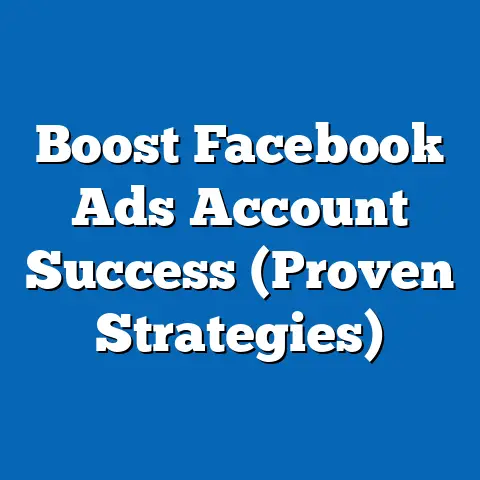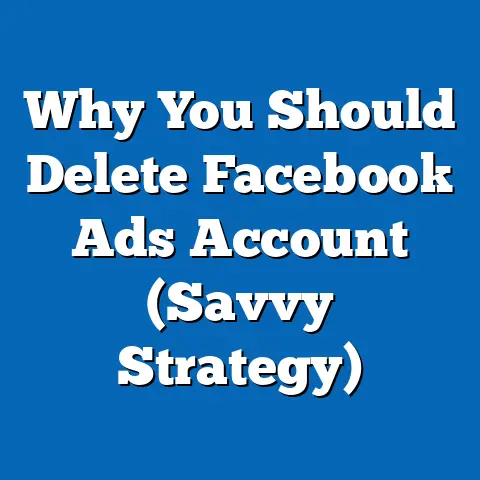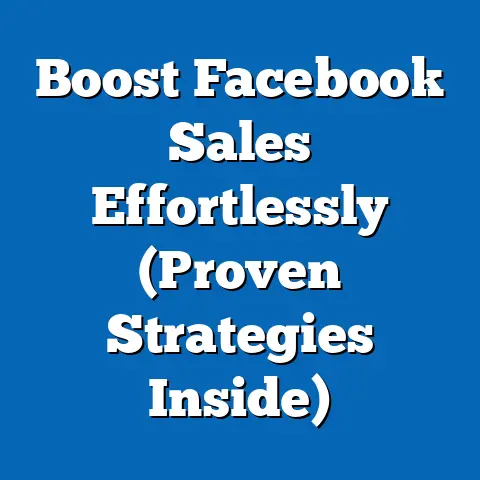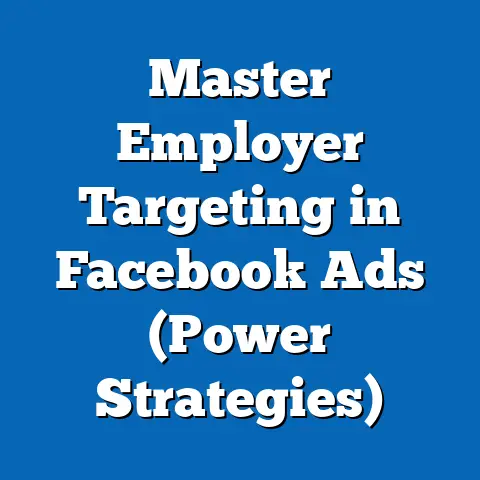Grant Access to Facebook Ad Account (Essential Strategies)
In the ever-evolving landscape of digital marketing, efficiency is key. Think of your business’s resources – time, money, and effort – as energy. Just as we strive to conserve energy in our daily lives, we should aim for the same in our marketing strategies. One often overlooked, yet crucial, aspect of efficient Facebook advertising is managing access to your ad account. Granting the right access to the right people can unlock significant time savings, improve campaign performance, and ultimately, boost your ROI.
I’ve seen firsthand how chaotic things can get when access isn’t properly managed. Imagine a team juggling multiple ad campaigns with limited visibility, or an agency struggling to get timely access to make crucial optimizations. It’s like trying to run a marathon with your shoelaces tied together! This guide is designed to untangle those laces and equip you with the knowledge and strategies to grant access to your Facebook Ad account with confidence and precision. Let’s dive in!
Understanding Facebook Ad Account Access
First, let’s establish a solid foundation. What exactly is a Facebook Ad Account, and why is it so important?
A Facebook Ad Account serves as the central hub for all your advertising activities on the platform. It’s where you create, manage, and track your campaigns, target your audience, set your budget, and analyze your results. Think of it as the control panel for your Facebook advertising engine.
Now, who gets to tinker with the controls? That’s where access levels come into play. Facebook Ads Manager offers three primary levels of access, each with distinct permissions and capabilities:
- Admin: This is the highest level of access, granting complete control over the ad account. Admins can manage users, change settings, create and edit campaigns, view reports, and even delete the ad account (so be careful who you give this to!).
- Advertiser: Advertisers can create and edit campaigns, view reports, and manage ad creatives. They cannot manage users or change the fundamental settings of the ad account. This is a suitable role for team members or freelancers directly involved in campaign execution.
- Analyst: Analysts have read-only access, allowing them to view reports and analyze campaign performance. They cannot make any changes to the ad account or campaigns. This is perfect for stakeholders who need to stay informed without having the ability to alter anything.
Choosing the right access level is critical. Giving someone too much access can lead to unintended errors or even security breaches. Conversely, granting too little access can hinder their ability to effectively perform their tasks. It’s all about finding the right balance.
Key Takeaway: Understand the different access levels and their implications before granting access to your Facebook Ad Account.
Importance of Granting Access
Why bother granting access at all? Can’t you just manage everything yourself? While that might be feasible for very small businesses with limited advertising activities, it quickly becomes unsustainable as your campaigns grow in complexity and scope.
Here’s why granting access is essential for businesses of all sizes:
- Collaboration with Agencies: If you’re working with a marketing agency, granting them access to your ad account is a must. It allows them to directly manage your campaigns, ensuring seamless execution and faster response times. I’ve worked with countless clients who initially hesitated to grant access, only to realize how much more efficient and effective our collaboration became once we had direct access to the ad account.
- Teamwork and Specialization: Within your own organization, different team members may have specialized skills. One person might be a whiz at audience targeting, while another excels at creating compelling ad creatives. Granting them appropriate access allows them to focus on their areas of expertise, leading to better overall campaign performance.
- Streamlined Communication and Accountability: When everyone involved in a campaign has access to the same data and insights, communication becomes much more efficient. It eliminates the need for constant back-and-forth emails and spreadsheets, allowing for quicker decision-making and more effective problem-solving. Plus, with clear roles and responsibilities defined by access levels, accountability is greatly enhanced.
- Scalability and Growth: As your business grows, your advertising needs will inevitably become more complex. Granting access to trusted team members or partners allows you to scale your operations without being bogged down by administrative tasks.
The numbers speak for themselves. A study by HubSpot found that companies that actively collaborate on marketing campaigns are 5x more likely to see a positive ROI. Effective access management is a foundational element of successful collaboration.
Key Takeaway: Granting access is crucial for collaboration, efficiency, and scalability. Don’t try to do everything yourself.
Here’s a detailed, step-by-step guide on how to grant access to your Facebook Ad Account:- Navigate to Business Settings: Log in to your Facebook account and go to Facebook Business Manager (business.facebook.com). If you don’t have a Business Manager account, you’ll need to create one. It’s free and essential for managing your business’s assets on Facebook.
- Select Your Ad Account: In Business Manager, click on “Business Settings” in the left-hand menu. Then, under the “Accounts” section, click on “Ad Accounts.” You’ll see a list of your ad accounts. Select the one you want to grant access to.
- Add People: On the Ad Account page, click on “Add People.” A pop-up window will appear.
- Enter Email Address: Enter the email address of the person you want to grant access to. Make sure you use the email address they use to log in to Facebook.
- Choose Access Level: This is the crucial step! Select the appropriate access level for the user (Admin, Advertiser, or Analyst). Remember to carefully consider their role and responsibilities before making your choice.
- Assign Tasks (Optional): Depending on the access level, you may be able to assign specific tasks to the user. For example, you can grant an Advertiser access to manage specific campaigns or ad sets.
- Confirm and Invite: Review your settings and click “Assign.” An invitation will be sent to the user’s email address.
- User Acceptance: The user will need to accept the invitation through their email or Facebook notifications. Once they accept, they’ll have access to your ad account with the permissions you’ve granted.
Important Notes:
- Business Manager vs. Ad Account Access: It’s important to understand the difference between granting access to your Business Manager and granting access to your Ad Account. Granting access to your Business Manager gives users access to all the assets within your Business Manager, including your Ad Account, Pages, and other tools. Granting access directly to your Ad Account only gives them access to that specific ad account.
- Existing Users: If the person you’re granting access to is already a user in your Business Manager, you can simply select them from the list of existing users instead of entering their email address.
- Troubleshooting: If the user doesn’t receive the invitation, check their spam folder or resend the invitation. You can also ask them to check their Facebook notifications.
Key Takeaway: Follow these steps carefully to grant access to your Facebook Ad Account securely and effectively.
Best Practices for Managing Access
Granting access is just the first step. To truly unlock the benefits of collaborative advertising, you need to implement best practices for managing access over time.
Here are some key strategies to keep in mind:
- Regularly Review Access Permissions: Make it a habit to review your ad account’s user list and access levels on a regular basis. Are there any users who no longer need access? Are the access levels still appropriate for each user’s current role? I recommend doing this at least quarterly, or more frequently if you have a lot of users or frequent personnel changes.
- Remove Access When Necessary: When someone leaves your company or their role changes, promptly remove their access to your ad account. This is a critical security measure that can prevent unauthorized access or data breaches.
- Implement Two-Factor Authentication: Encourage all users with access to your ad account to enable two-factor authentication (2FA) on their Facebook accounts. This adds an extra layer of security by requiring a code from their phone in addition to their password. It’s a simple step that can significantly reduce the risk of hacking.
- Establish Clear Communication Channels: Make sure everyone involved in your advertising efforts understands their roles and responsibilities. Clearly communicate who is responsible for what tasks, and establish clear channels for communication and collaboration. This can help prevent confusion, duplication of effort, and errors.
- Document Your Access Management Policies: Create a written policy outlining your procedures for granting and managing access to your Facebook Ad Account. This ensures consistency and helps new team members understand the process.
- Educate Your Team: Provide training to your team members on best practices for using Facebook Ads Manager and protecting your ad account. This can help prevent accidental errors or security breaches.
Key Takeaway: Proactive access management is essential for maintaining security, efficiency, and control over your Facebook advertising efforts.
Common Challenges and Solutions
Even with the best intentions, granting access to your Facebook Ad Account can sometimes present challenges. Here are some common issues and practical solutions:
- Confusion Over Roles and Permissions: It’s easy to get confused about the different access levels and what each one allows. Solution: Refer back to the definitions of Admin, Advertiser, and Analyst. Before granting access, clearly explain to the user what their role will be and what permissions they’ll need.
- Security Concerns: Some business owners are hesitant to grant access to their ad account due to security concerns. Solution: Implement the best practices outlined above, such as two-factor authentication and regular access reviews. Only grant access to trusted individuals or organizations. Consider using a contract or non-disclosure agreement (NDA) to protect your confidential information.
- Technical Issues: Sometimes, users may have trouble accepting invitations or accessing the ad account. Solution: Double-check the email address you entered to ensure it’s correct. Ask the user to check their spam folder or Facebook notifications. If the problem persists, try removing the user and re-inviting them.
- Lack of Accountability: If you’re not seeing the results you expect from your advertising campaigns, it can be difficult to determine who is responsible. Solution: Define clear metrics and key performance indicators (KPIs) for each user or team. Regularly monitor performance and provide feedback. Use reporting tools within Facebook Ads Manager to track progress and identify areas for improvement.
- Overlapping Access: Granting multiple users overlapping access to the same campaigns or ad sets can lead to confusion and conflicts. Solution: Clearly define responsibilities and assign specific tasks to each user. Use naming conventions to clearly identify who is working on what.
Key Takeaway: Be prepared to address common challenges and have solutions in place to ensure smooth and secure access management.
Conclusion
Granting access to your Facebook Ad Account is not merely a technical procedure; it’s a strategic imperative that can significantly impact your advertising efficiency and overall business success. By understanding the different access levels, implementing best practices for managing access, and addressing common challenges proactively, you can unlock the full potential of collaborative advertising.
Think of it this way: your Facebook Ad Account is a powerful engine that can drive your business forward. Granting the right access to the right people is like assembling a skilled pit crew that can fine-tune your engine, optimize your performance, and help you cross the finish line faster.
So, take the time to carefully evaluate your access management policies and implement the strategies outlined in this guide. You’ll be amazed at the energy savings, improved collaboration, and enhanced results you’ll achieve.
Call to Action
Now it’s your turn! Have you implemented these strategies for granting access to your Facebook Ad Account? What challenges have you faced, and what solutions have you found? Share your experiences in the comments below!
Do you need further assistance optimizing your Facebook advertising strategies? Reach out to me for personalized tips and advice. Together, we can unlock the full potential of your Facebook Ads!






